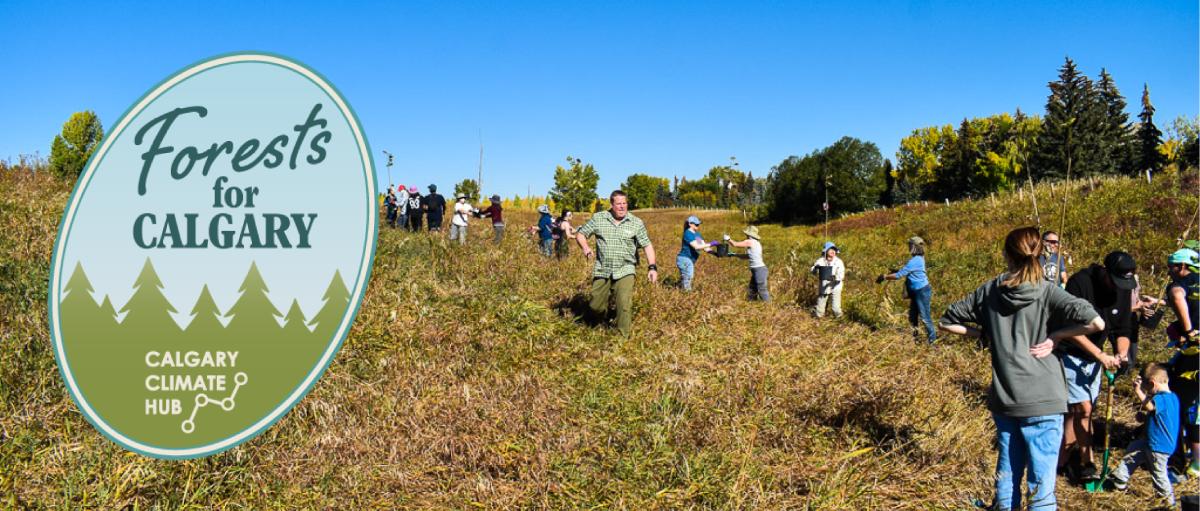Forests for Calgary
Organization: Calgary Climate Hub
Funder: Green Communities Canada
Websites: https://www.calgaryclimatehub.ca/forests_for_calgary
Project description
Forests for Calgary is a collaboration between The Calgary Climate Hub and Green Communities Canada that is helping to grow Calgary’s tree canopy. They are planting “tiny forests” using the Miyawaki method. This method uses trees, bushes and wildflowers that naturally grow in this area, placing them much closer together than normal. The result is a faster growing forest, which is a great tool for quickly making green spaces or ‘tiny forests’ in our neighbourhoods.
The goal of this project is to grow more trees in the Calgary area, as they provide many benefits to Calgarians. Indigenous project manager Heather Morigeau custom designs these tiny forests to suit each location, with local groups caring for these forests long-term.

A guidebook has been created to help organizations start their own Forests for Calgary projects. There will also be public tree equity workshops hosted by Calgary Climate Hub staff and volunteers.
Read the GuidebookBenefit to Calgarians
Urban forests reduce air pollution, lower heating and cooling costs for homes, and reduce the effects of floods, droughts and heatwaves. They also support people’s health and well-being, creating green spaces for communities to enjoy.
In northeast Calgary, ‘tiny forests’ have already been planted at The Genesis Centre and at Bob Edwards School – the Marlborough Tiny Forest. The Genesis Centre’s tiny forest is shaped like a fox and includes more than 1,000 plants; whereas the Marlborough Tiny Forest is shaped like a leaf and features more than 2,000 trees and plants. Around 300 volunteers have helped plant and care for these forests, building strong connections between people and nature along the way.

Climate impact
Trees are important in removing carbon dioxide from the atmosphere. One fully grown tree can remove an estimated 48 pounds of carbon dioxide each year. Faster tree growth means more carbon dioxide being removed from the atmosphere sooner. The Miyawaki method is one way this is being accomplished. By placing one tree, two bushes and one wildflower in a square metre space, these plants are forced to compete for sunlight, speeding up growth and helping remove carbon dioxide from our air much sooner than in traditional forests.
Together, Calgary’s tiny forests are expected to absorb over 85,000 pounds of carbon dioxide every year.
- Bowmont Park Tree Planting Event: 200 trees = 9,600 pounds absorbed per year.
- Marlborough Tiny Forest: 500 trees = 24,000 pounds absorbed per year.
- Centre for Spiritual Living (CSL) Tiny Forest: 800 plants, roughly 200 of each layer
- Bowness Community Tiny Forest: roughly 600 plants, about 150 of each layer
- Genesis Centre Tiny Forest: just over 800 plants, roughly 200 of each layer
In 2025, Calgary Climate Hub and The City also planted a new tiny forest in Saddlecrest, adding 400 trees to Calgary’s urban canopy.
Communities that want to take similar action can learn more through the Calgary Climate Hub’s Nature Based Solutions Program.
In a Miyawaki forest, each layer refers to canopy, subcanopy, shrub and understory plants.

Innovation and inclusion
All the forests for this project included consultation with Indigenous land-care Knowledge Holders, including designer Heather Morigeau, a member of the Metis Nation of Alberta with ancestral connections to the Ktunaxa Nation. Elder Marilyn Shingoose of the Saulteaux Nation led a blessing prior to each forest planting and offered teachings about the Indigenous worldview which sees trees and plants as our relatives. Bowness Community Association (BCA)’s tiny forest arranged the trees and plants into a Medicine Wheel design with foliage, flowers and berries grouped together based on the colours of yellow, red, black and white.

Before moving forward with this design, the BCA engaged Bowness Indigenous community members during consultation events, so that the design would reflect the knowledge gathered from these events. The hope is that this tiny forest becomes a place of learning, gathering and sharing wisdom with future generations.
The Forests for Calgary guidebook includes details about the plants used in the BCA design and their significance to the Indigenous Nations of these lands. The Forests for Calgary initiative is guided by a steering committee including Jared Blustein, Heather Addy, Rob Miller, Lyndsey McDonald, Kerry Ross and Ekager Rahil


